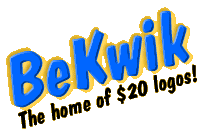
![]()
Virtually
Free Logo Design
Logo Samples
Low
Cost Logos FAQ
Why Low Cost Logos?
Testimonials
![]()
Virtually
FREE Logo Design!
Includes
E-book: How to Create Fortune
on the Internet with 4 Simple Steps
worth $37
Get
it when you order a logo from us! ![]()
FREE
Report: How to Create Brand Awareness without
Mass Advertising
Get it FREE when you subscribe to our cutting edge newsletter "Brand your Business" below!
![]()
Logo
Design Articles
Branding Articles
Marketing
Articles
Design Articles
Printing
Articles
Logo Design Software
Logo
design Books![]()
Order
NOW - We accept: ![]() .
.
![]() .
.![]()
![]() .
.
![]() .
. ![]()
|
|
Design Your Logo Like a Proby
Eileen Parzek A logo is the image which represents a company or its product. Its function is to create a memorable, recognizable impression on the mind of a potential client or customer. A logo is essentially at the heart of a corporate identity. So what makes a "good" logo? Most people would answer "I just know it when I see it!" and this isn't so far from the truth. A good logo catches the eye - it makes the observer curious or engaged, if only for a short moment… a moment in which an image and the existence of your company is embedded in the mind rather than filtered out with a million other daily stimuli. But even if a good logo 'just is', there are elements for making it happen … and we will look at some of those. I will also discuss some of the issues designing logos which work in two distinct worlds - print and online. There are three basic types of logos, which can be used alone or combined within one design:
Once a form for the logo has been defined, color needs to be considered. Again, color for a logo should remain simple. You can always get fancy with the web version, but a good logo must work well in one color and gradients of that color. The color should enhance and support the form of the logo - for example, various shades of blue on the sides of a 3D box should be the same as they would in real life. Contrast is another powerful concept in the creation of logos - you can contrast size, color, fonts, textures - to create visual interest. A logo should be simple and abstract, not be complicated or confusing, and again, all elements must be discernible when reproduced in small sizes. A good logo works in the simplest form. With the advent of the Web, it is common to see logos which contain gradients, 3D effects, animation, and other visual effects. But if the logo can not also be reduced to a simple one color flat version for use on faxes, your checks and photocopied documents, it is functionally useless. As tempting as it might be to create a whiz-bang logo, a designer must always consider all the ways your companies identity will be disseminated. Once this is successfully accomplished, you can always jazz up your logo later for the web! As mentioned before, size is a critical issue when having a logo designed. A good rule of thumb is that if the logo works well in a business card size, it will scale up nicely to other sizes. Always make sure your logo looks pleasing on paper and in a wide range of sizes before committing to it. Web and print are two entirely different mediums. If you are having a logo designed for the first time, it is essential that you be aware that your logo must be designed for print FIRST and web second. Without getting into the intricacies of print and web resolutions, suffice it to say they are very different. What might look great on your computer screen will likely print out at the size of a postage stamp and be entirely muddled. If the logo is designed to look great online, depending on the graphics format, it might not scale easily up to a printable version, so it is best to create it in a way that can be downscaled. When choosing a color for your logo, you might want to consider using those in the universal 216 color palette supported by all web browsers. This will ensure that the colors of your corporate identity can be used online without a hitch. On the flip side, the web will allow you to take your simple 1-2 color logo and do great things with it - and it won't cost you thousands of extra dollars to add colors to it, make it 3D or animate it, like it would in the print medium. Once your logo is created for the lowest common denominator, the same form can be enhanced in a myriad of ways to look more exciting for your web site. Just be sure you don't get carried away with the possibilities until you have a logo which will present a strong image for your company on a simple business card! Eileen 'Turtle' Parzek is a veteran marketing designer and online communications consultant who has been working from home and virtually since 1995. Her business, SOHO It Goes! (www.soho-it-goes.com) specializes in providing technology driven design, marketing and communication services to small businesses and organizations.
|